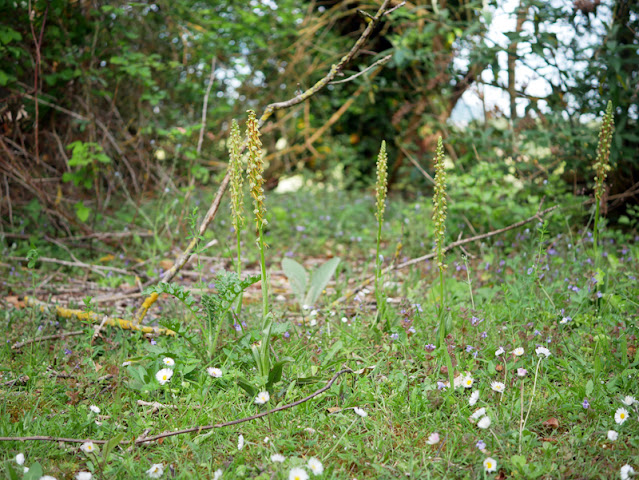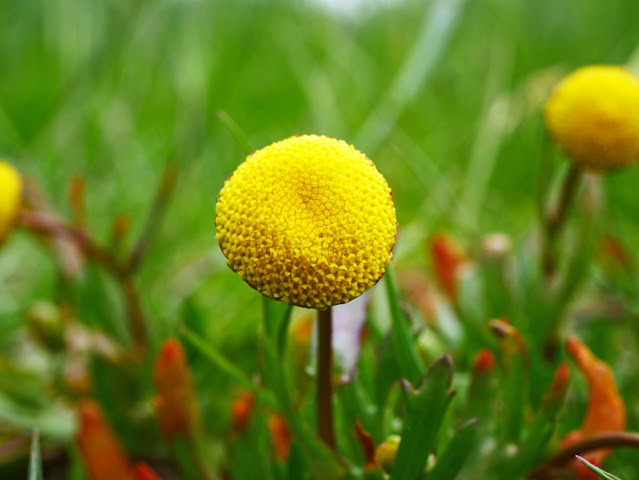June 2021 - Botanical Finds from Kent
Here is a round up of my best botanical finds for June, including beautiful, rare or amazing plants.
First up is Sea Clover, a Kent RPR species from the Isle of Grain. Too early here for seeds which in itself are distinctive, but the flowers are about half the size of Red Clover and look pinker.
Trifolium squamosum
It being June, I suppose there must be orchids! One of our most impressive is a hybrid between Common Spotted and Southern Marsh. They are usually much bigger than either parent, so are easy to find.
D. x grandis
In a dry area not far away from this massive hybrid orchid was a stand of Man Orchids. These were quite fortunate, as a new road had been built missing them by yards. I do expect they will colonise the new road verge in the next years or so or at least until they scrub over in years to come.
Orchis anthropophora
Knotted Clover on Littlestone Warren. Much smaller than inland specimens I've seen.
Trifolium striatum
Even smaller was Subterraneum Clover which buries its seeds in the ground. I've yet to find this when in seed, but then they are tiny and you'd have to actually look for it.
Trifolium subterraneum
This cabbage family plant looked different and I didn't recognise it. It was in fact Warty Cabbage and the leaves and stem are covered in little warts. What a treat to find a new species. This was in the old bomb crater on Blackheath were I used to ride my bike when a kid.
Bunias orientalis
Still at Blackheath around and in a pond was Buttonweed, an alien species. Apparently it has been here for many years no doubt originally illegally introduced. I've only ever seen it before near Higham Marshes.
Cotula coronopifolia
I thought I would break up the Clovers with some Sand Spurrey. This is actually quite rare and is often confused with Lesser Sea Spurrey which is far more common. It likes sandy soils.
Spergularia rubra
The penultimate Clover I am featuring in this blog, this is Clustered Clover which actually do look weird and can't really be mistaken for any other species.
Trifolium glomeratum
The last Clover is the amazing Woolly Clover, an alien species that established at Blackheath many years ago and seems to be doing quite well. It looks a bit like Strawberry Clover, but it's quite dense with prostrate woody stems too.
Trifolium tomentosum
Here's a basal leaf dying off. There's not much like these around either, so you can identify them without flowers as these come up before the flowers.
Ivy Broomrape is rare in Kent but North Kent has the biggest populations around the Dartford to Greenhithe areas. In past years they have all been the usual deep purple colours, but this year a new population arose up the hill from McD's at Greenhithe and they were all yellow forms! Amazing sight.
Orobanche hederae
One of my most exciting finds was a single spike of flowering Lizard Orchid in Longfield in 2019 on a private meadow. Drought seemed to have killed it off in 2020 but it came back in 2021 and on having another look around, I found a further 5 spikes nearby, so 6 spikes in total. The landowner was impressed too and hopefully will manage the site for them sympathetically. This is quite important as the site is scrubbing over.
Himantoglossum hircinum
One of the latest additions to the Kent RPR is this Mediterranean Long Tongue Orchid. A contact told me where it was (I hadn't asked) so I went to look. I was obviously one of many as the area around it had been flattened. It was supposed to be a secret and I did not publish this on social media to help protect the site at the time.
Once I visited the site, I was of the opinion that it was a prime dumping site and in my view the consideration that these came from fly tipped waste cannot be ruled out. Against this view was that there were no other alien species there and a verge by the M20 certainly isn't a venue where one might plant a specimen. This is the second year they have been here and are different to the Tongue Orchid species in Essex and Wakehurst.
Serapias vomeracea
Please don't ask where they are, the site is already under pressure, so I won't say!I can't say they look attractive to me compared to other orchids.
Why couldn't a Mirror Orchid (Ophrys speculum) turn up somewhere?
Much more exciting to me was finding Small Catchfly and what's more they were doing better than 2 years ago when I saw a poor looking lone specimen. Such a pretty little flower of arable field edges and quite rare now. Near Tutt Hill, Ashford area.
Silene gallica
Dungeness is home to hundreds of thousands of Nottingham Catchfly plants, whereas they are absent from most of the rest of the county apart from a few other coastal locations. The shingle ridges are covered with them in flower from late May into late June, but here's the thing, virtually every single one has white flowers; so, it was quite exciting to find a few clumps of deep pink flowers near Boulder Wall, Dungeness
The petals unfurl at night to attract moth pollinators.
Silene nutans
Just my luck to find the rare Rough Mallow at Ranscombe Farm on a dull, cloudy day. as such, the flowers are half closed! Still, it shows the plant form quite well.
Finally, the beautiful flowers of Hoary Plantain, a Kent RPR species that look like an orchid from afar and it has no petals! An indicator plant of a great habitat. Here seen near Great Crabbles Wood.
Plantago media
That's it for June 2021. I missed off a lot of wildflowers, but hopefully included enough unsual plants to whet your appetite to get out there and find some of your own. Those featured will be in seed or gone over now, but July brings forth new species such as water plants. So get out there and find them before I do.
Take care
Dave
Twitter: @Barbus59































Comments
Post a Comment
Comments welcome from those interested in my articles. For spammers don't bother as I moderate all comments prior to posting them.